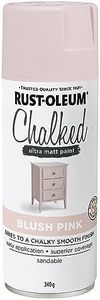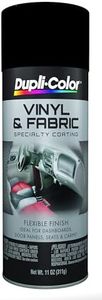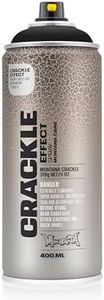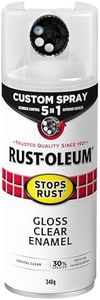We Use CookiesWe use cookies to enhance the security, performance,
functionality and for analytical and promotional activities. By continuing to browse this site you
are agreeing to our privacy policy
10 Best Spray Paints
From leading brands and best sellers available on the web.By clicking on a link to a third party's website, log data is shared with that third party.
Buying Guide for the Best Spray Paints
Choosing the right spray paint can make a big difference in the outcome of your project, whether you’re painting furniture, walls, crafts, vehicles, or metal surfaces. The key is to match the spray paint’s features to your project needs. Before buying, consider what surface you’re painting, whether it’s indoors or outdoors, the look you want to achieve, and how durable the final result needs to be.Base TypeSpray paints come in different base types, with the most common being water-based (acrylic) and oil-based. The base type affects how the paint bonds to surfaces, its drying time, odor, and how easy it is to clean. Water-based spray paints are less smelly, quicker to dry, and easier to clean up with water, making them ideal for indoor or craft use. Oil-based ones are tougher and more durable, better suited for outdoor or heavy-use areas, but they take longer to dry and need solvents for cleaning. To decide, think about where and what you’re painting and pick a base type that matches those conditions and your comfort with cleanup.
FinishThe finish of a spray paint describes how shiny or matte the dried surface looks. Common finishes include matte (dull), satin (slightly shiny), gloss (shiny), and specialty finishes like hammered or metallic. Matte finishes are great when you want a subtle, non-reflective look. Gloss is best for bright, vibrant, or easy-to-clean surfaces, while satin sits between the two. Specialty finishes like metallic add decorative appeal. Think about the style you want and how visible imperfections may be – shinier finishes highlight flaws, while matte can hide them.
Surface CompatibilityNot all spray paints stick well to every surface. Some are made specifically for wood, metal, plastic, glass, or masonry. This information is usually on the label. Choosing the right one ensures strong adhesion, lasting color, and fewer chances of peeling or flaking. Pick a paint marked as suitable for your specific project material to get the best results.
Drying TimeDrying time refers to how quickly the spray paint not only feels dry to the touch (surface dry) but also how soon you can handle or recoat it. Fast-drying paints are handy for quick projects or multi-coat jobs, while slower ones might allow for smoother finishes as they self-level. The right drying time depends on your schedule and your desired finish — if you need speed, look for quick-dry options; if quality and evenness are your priority, slightly longer drying times might be better.
Coverage AreaCoverage area tells you how much surface a single can will paint, often listed in square feet or meters. This depends on both the paint’s formula and how thickly you apply it. High-coverage paints mean fewer cans to buy and less interruption during your work. Consider the size of your project, and check the can’s stated coverage to ensure you have enough paint.
Durability and Weather ResistanceDurability determines how well the finished paint job holds up over time, especially when exposed to things like rain, sunlight, or abrasion. Some spray paints are designed for outdoor use and have UV, water, or rust resistance. If your project lives outside or in a tough environment, prioritize paints marked as weather or rust-resistant; for indoor or decorative items, basic durability will suffice.
Spray Nozzle TypeThe spray nozzle controls how the paint comes out — its width, consistency, and comfort. Adjustable or comfort nozzles can help you cover wide areas quickly or do detail work, and they reduce finger fatigue if you have a big project. Traditional nozzles are fine for simple tasks. If you’re painting for a long time or need precision, look for a can with an ergonomic or adjustable nozzle.















